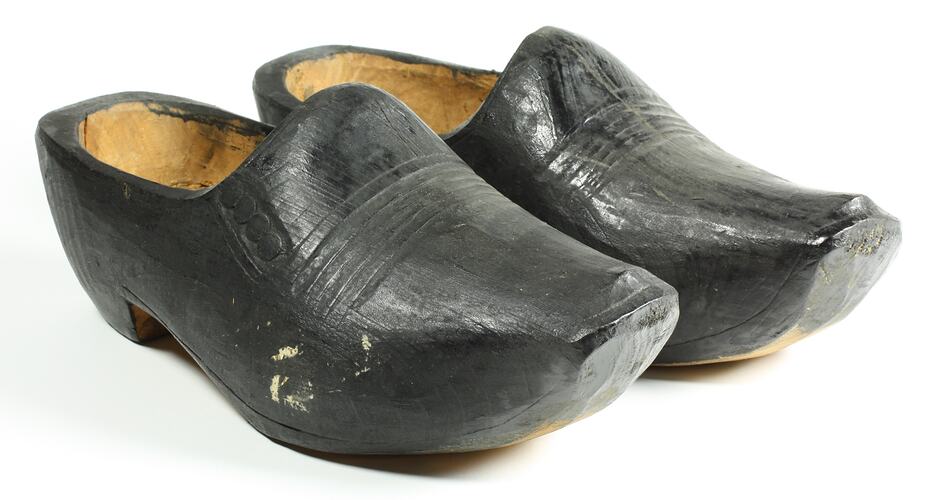Summary
Alternative Name(s): Clogs, Wooden Shoes
Pair of black wood sabots. Acquired by Museum Victoria in 1884 from the Belgian (aka Belgium) Export Company.
No reference to the Belgian Export Co can been found in the 1880 Melbourne International Exhibition Official Record - it was established two years afterwards, in 1882. It was considered 'one of the practical results of the Melbourne International Exhibition' - prematurely, as the company was liquidated in 1885.
'Sabot' is the French word for clog or wooden shoe.
Physical Description
Pair of wood sabots, carved and painted black on the exterior. Upturned, square toe. Several parallel ridges across the vamp. Carving suggests flap with buttons to secure.
Significance
The sabots are significant as a material record of the Belgian (aka Belgium) Export Company.
On 5 April 1882 (p.2), the Brisbane Courier reported that 'Other markets are opening up for Australian produce in various parts of the world, and one of the latest instances of the important position the produce of Australia is assuming in Europe is the announcement of the formation of the Belgium Export Company, with a capital of £200,000, which company is one of the practical results of the Melbourne International Exhibition. The object of the directors is to encourage and promote, by every possible means, the extension of commerce between Belgium and the Australian colonies. Messrs. Be Tania, Mackley & Co., of Melbourne, have been appointed general agents for Australasia, and if the business prove successful, there will .soon be other agencies in the principal Australian cities. Some of the shareholders, it is stated in the prospectus, were exhibitors in the Sydney and Melbourne Exhibitions, and they arc anxious to extend their trade with the colonies. The establishment of an agency in Melbourne, having the twofold object of promoting an export and import trade, cannot fail to be of service to us, and the advantage appears to ne greatly in our favour. A large quantity of Australian produce, particularly wool, is already finding a ready sale at Antwerp, and Belgium is not only a large consumer of wool, tallow, hides, grain, and metal, but she is also a great carrier of the raw material for the French, German, and Swiss markets. It will thus be seen that a fine opening, to the advantage of the Belgian and Australian producers has been made and the mutual interchange of commodities will undoubtedly promote the prosperity of both countries.'
An example of the Belgium Export Company's business in the following years was reported on 9 September 1882 (p.321) in The Queenslander, which advised that the Belgium Export Company had successfully tendered to the Railway Department (presumably of Queensland) for the supply of 3000 tons of steel rails. The amount of the tender was £195,500. In 1883 the Belgium Export Comany is reported as unsuccessful tenderer for the supply of 14 inch water mains and plant in Otago, New Zealand, 'on the grounds of informality' (Otago Daily Times , Issue 6576, 13 March 1883, Page 2). The company had more success in Australia: in 1885 they were delivering iron pipes to Sydney (Sydney Morning Herald, 23 May 1885, p.11). But in the same month, the Maitland Mercury & Hunter River General Advertiser reported that the Belgian Export Company had suspended operations (16 May 1885, p.9 S). The Argus reported on 30 May that it had been liquidated (p.9).
More Information
-
Collecting Areas
-
Acquisition Information
Donation from Belgian Export Co, 26 Jul 1884
-
Place Made
-
Previous Owner
-
Classification
-
Category
-
Discipline
-
Type of item
-
Keywords
Exhibitions: Melbourne International, 1880-1881, Export Trade, Import Markets
